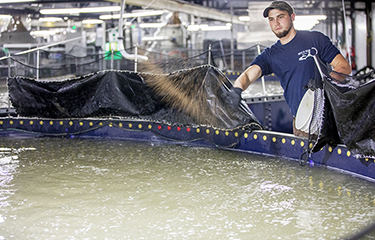Steelhead trout is a common enough species on the U.S. West Coast, being native to California, Oregon, and Washington. But the fish didn’t find its way to the East Coast markets in a significant volume until farm-raised steelhead started being produced in the region.
Hudson Valley Fisheries, located in Hudson, New York, may operate the largest land-based commercial-scale steelhead farm in North America, but the company’s leaders are relatively new to the seafood industry.
John Ng, the company’s president, said aquaculture has been a way to diversify the family business, which operates mainly in metals recycling and stems from a business his father built in Greenpoint, Brooklyn, in 1983. Through some business contacts, Ng was introduced to the world of aquaculture in 2012.
“Part of our thinking was that the world’s oceans are under such tremendous strain, both from environmental and industrial factors, and the only way this industry can help negate those effects is to start raising fish on land,” Ng told SeafoodSource.
Ng was discussing the potential of jumping into the aquaculture with his cousin over sushi when someone overheard and made them aware of a space for sale – an operation in Hudson that had just recently closed its doors. And so the banks of the Hudson River quickly became the site of a new venture.
“We came to this thinking we wanted a commercial-scale operation, not a mom-and-pop shop,” Ng said. “We went with something of a size that will be impactful to the market and impactful to the industry.”
The company is currently at around 30 percent production, with a plan to produce between 1,000 and 1,200 metric tons of steelhead, which it expects to hit by the end of the year. The recirculating aquaculture system (RAS) facility is about 160,000 square feet, and has 54 tanks ranging from eight to 45 feet in diameter.
“I know at 1,000 tons is still relatively small, considering some of the big projects that are on the drawing board and are being built now,” Ng said. “But it’s a good step forward to establish systems and processes, all the kinds of business infrastructure we’ll need to be successful and expand in the future.”
Hudson was the ideal location in terms of its proximity to New York and Boston.
“We wanted to establish an operation close to market,” Ng said. “We wanted to really take advantage of what RAS can do for a business, which is the ability to grow close to your consumers and make that shift from shipping fish thousands of miles to market.”
While buying local has been a long-growing trend in the downtown streets of cities and with small-scale fishermen selling their catch off the boat, Hudson Valley Fisheries wants to be a leader in bringing the concept to the farm-raised fish market. One of the ways its convincing customers to try “salmon’s tastier cousin” is by feeding them data on sustainability.
“One of the key or one of the most responded to angles of what we're doing is the lower carbon footprint of our operation,” said Ng, noting the company compares the carbon footprint of its operations to that of wild fish from British Columbia or farm-raised fish from Chile traveling to the eastern U.S. “When you put the numbers out like that in front of consumers, they really start thinking about it and it makes it an easier decision to give a different protein a go.”
Right now, the company delivers to a collection of upscale grocers and fine dining restaurants in Boston, New York, Philadelphia, and Washington D.C., and does some straight-to-consumer delivery.
Earlier this year, Hudson Valley Fisheries became the first aquaculture producer to be included in the New York State Grown and Certified Program, a program the promotes New York's farmers and food producers who adhere to higher food safety and practices and environmental standards. The program includes over 20 wild-caught seafood producers.
While the company is still building a market in New York and the eastern U.S., Ng has made it clear that the first facility is not a one-and-done operation.
“We’re ramping this up slowly, making sure everything works properly. We have to put in the work, we have to build it – make sure we aren’t over- or under-producing and introducing ourselves to the market correctly,” Ng said. “But this is definitely going well, we’re excited to reach full capacity this year and use this as a model for larger facilities elsewhere down the road.”
Photo courtesy of Hudson Valley Fisheries







